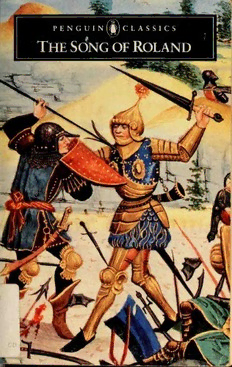
The Song of Roland PDF
Preview The Song of Roland
PENGUIN CLASSICS . (||) The sdNG of Roland BOSTOl^ PUBLIC LIBRARY . PENGUUIINN (AN) CLASSICS 1 THE SONG OF ROLAND Glyn Burgess is Reader in French at the University of Liverpool where he has taught since 1971. He was educated at St John's College,Oxford,McMasterUniversity,Hamilton,Ontario,andthe University of Paris (Sorbonne). He has taught at universities in Canada and the United States and is the author of a number of articlesonOldFrenchLanguageandLiteratureinlearnedjournals andofseveralbooks,includingContributional'etudeduvocabulaire pre-courtois(1970), Chretiende Troyes:ErecetEnide(1984)and The Lais ofMarie de France: Text and Context (1987). He is also the co-author(withKeithBusby)ofthetranslationinPenguinClassics oftheLaisofMariedeFrance n The Song Roland of TRANSLATED WITH AN INTRODUCTION AND NOTES BY GLYN BURGESS PENGUIN BOOKS PENGUIN BOOKS PublishedbythePenguinGroup 27WrightsLane,Londonw85TZ,England VikingPenguinInc.,40West23rdStreet,NewYork,NewYorklooio,USA PenguinBooksAustraliaLtd,Ringwood,Victoria,Austraha PenguinBooksCanadaLtd,2801JohnStreet,Markham,Ontario,CanadaL3RiB4 PenguinBooks(NZ)Ltd,182-190WairauRoad,Auckland10,NewZealand PenguinBooksLtd,RegisteredOffices:Harmondsworth,Middlesex,England Firstpublished1990 987654321 10 © Copyright GlynBurgess,1990 Allrightsreserved MadeandprintedinGreatBritainby CoxandWymanLtd,Reading,Berks. FilmsetinLinotronPlantinby RowlandPhototypesettingLtd,BuryStEdmunds,Suffolk ExceptintheUnitedStatesofAmerica, thisbookissoldsubjecttothecondition thatitshallnot,bywayoftradeorotherwise, belent,re-sold,hiredout,orotherwisecirculated withoutthepublisher'spriorconsentinanyformof bindingorcoverotherthanthatinwhichitis < publishedandwithoutasimilarcondition y^t'. includingthisconditionbeingimposed -tv* onthesubsequentpurchaser c.C'" i Contents Introduction 7 ANoteontheTranslation 27 TheSongofRoland 29 Notes 157 GlossaryofUnusualTerms 160 Bibliography 162 Appendix: LaChansondeRoland 164 IndexofProperNames 211 Digitized by the Internet Archive in 2011 http://www.archive.org/details/songofrolandOOburg j Introduction The Bodleian Library in Oxford houses a small, rather insignifi- cant manuscript designated as Digby 23 and containing a single poem which lacks a title. This poem was first published (Paris, 1837) under the title La Chanson de Roland ou de Roncevaux by FrancisqueMichel,whorecordshowhediscovereditinJuly 1835. Ithascometobeknown simplyastheChansondeRoland(Songof Roland). The manuscript, executed in the twelfth century (prob- ably between 1130 and 1170), presents a number of linguistic features reflecting the Anglo-Norman dialect, the French spoken in England for some three hundred years after the Norman Con- quest. It containsanumberoferrorscommitted by the scribeand has been touched up in over sixty places by a twelfth-century reviser. Manuscript Digby 23 is certainly not the poet's original, but someoftheerrorssuggestthatitrepresentsthecopyofacopy ofthe original (see Whitehead, pp. vi-vii).^ It isalso not theonly surviving manuscript ofthe Song ofRoland. Two versions in the Library of St Mark in Venice (fourteenth century, known as Venice IV; late thirteenth century, known as Venice VII), ver- sions in the Municipal Libraries of Chateauroux (late thirteenth century) and Lyon (fourteenth century), in the Bibliotheque Nationale in Paris (late thirteenth century), in Trinity College, Cambridge(fifteenthcentury)andsomefragmentary French texts attest to the popularity ofthe legend of Roland, even when they lackthesophisticationandpoeticdensityoftheOxfordtext. These French versions are derived, like that in Digby 23, from a lost original(seeSegre,p. xiv). AlsoextantareadaptationsintoMiddle High German (the Ruolandsliet), Old Norse (the Karlamagnus- * FulldetailsofworksreferredtoaregivenintheBibliography,pp. 162-3. . INTRODUCTION saga), Welsh (Can Rolant), Dutch (the Roelantslied) and Middle English(SongofRoland) TheprecisedateofcompositionoftheOxfordversionisdifficult to determine. The numerous proper names, of individuals and places, seem at first sight to offer a fruitful source ofinformation. But many appear to be the product of poetic invention. Some, however,havemadescholarswonderwhetherthepoethadinmind a specific historical event. Allusions to the Col de Cize (vv. 583, 719, 2939), Tudela (v. 200) and Valterne (vv. 199, 931, 1291, interpreted as Valterra on the River Ebro) may be a reflection of battles fought in these places at the end ofthe eleventh century. The statement, placed in the mouth of a pagan, that Charles crossedtheseatoEngland(v. 372)lookslikeareferencetoWilliamI and the Norman Conquest, and mention of victories in Apulia andCalabriacouldwellreflecttheactivitiesoftheNormanRobert GuiscardinsouthernItalyinthelateryearsoftheeleventhcentury. In his Roman de Rou, written about 1160, the poet Wace claims that a song of Roland was sung to the Normans by a certain TailleferbeforethebattleofHastings.* The poem has been dated as early as 1060 and as late as the second half of the twelfth century, but the most frequently accepted date is around the very end of the eleventh century (1098-1100). This would place the poem at the time ofthe First Crusade. Indeed the inclusion of a rehc of the Holy Lance in Charlemagne's sword (w. 2501-9) has been seen as an allusion to the revelation to Peter Bartholomew which resulted in the dis- covery of the Lance of the Crucifixion in Antioch in 1098. This discovery improved the moraleofthe Crusaders, who were under siegefromtheforcesofKerbogha,andtheyimmediatelyuseditin theirsuccessfulbattleinJune 1098 againsttheirArabandTurkish opponents. ThesettingoftheSongofRolandisnorthernSpainand CharleshimselfdidleadacampaigninSpainintheeighthcentury. In the eleventh century Christian forces, consisting mainly of Franks,alsoundertookexpeditionsto Spain. Buttheoverallspirit ofthe poem appears to be that ofthe First Crusade. All in all the LeRomandeRondeWace,ed.A.J.Holden,3vols(Paris,Picard,i970-73)> H? w.8013-18(seealsov.8935).
